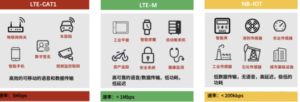When designing Internet of Things (IoT) devices for large-scale connectivity, choosing the appropriate LTE IoT standard is a challenge we must address from the outset of the product design. This decision affects the hardware requirements of our devices and the carriers used at launch.
As 2G and 3G networks phase out, current large-scale cellular IoT devices may utilize the following 4G LTE standards: LTE Cat.1, LTE-M, or NB-IoT. Understanding the characteristics and differences of LTE Cat.1, LTE-M, and NB-IoT is crucial in making this choice.
LTE Cat.1
LTE Cat.1, defined by the 3GPP in its Release 8 in 2008, allows for maximum data transfer rates of 5 Mbps upload and 10 Mbps download. Common applications include IoT retail solutions, home security systems, smart wearables, and smartwatches.
NB-IoT
With the shift towards lower-cost chipsets and modules for IoT systems that do not require high transmission rates, the Narrowband IoT (NB-IoT) standard is designed for low- data demand devices. Set by Release 14 of the 3GPP, it caps the data transfer rate at approximately 160 Kbps. If high data rates are not essential, choosing NB-IoT can significantly reduce product costs and power consumption. The benefits of NB-IoT include low power usage, extensive coverage, high connection density, and low cost. Typical applications are in smart agriculture, smart building solutions, environmental monitoring, and industrial IoT sensors.
LTE-M
Offering data transfer rates between NB-IoT and Cat.1, LTE-M supports up to 1.1 Mbps. It reduces costs, power consumption, and network capacity requirements for large-scale IoT systems. LTE-M is ideal for global markets as it is compatible with all cellular networks worldwide. Its primary benefits include higher data rates suitable for applications such as voice and low-speed video, cost-effective positioning technology, ideal for logistics, mobility support, and VoLTE capability. LTE-M is commonly used in smart cities, smart homes, and healthcare.

Deciding between NB-IoT, Cat.1, or Cat.M
The choice depends on the specific needs of the EBYTE product.
- Product Performance: Evaluate if high data transmission rates are critical. If so, Cat.1 may be necessary. Also, take into account power consumption, latency, and reliability, especially for mobile or battery-powered devices.
- Cost: Factor in development, materials, and operational costs, especially if the product will be used for an extended period.
- Project Timeline: Consider the complexity of development, supply chain lead times, and testing challenges.
By evaluating these factors, the most suitable standard can be determined for the project or product requirements.


